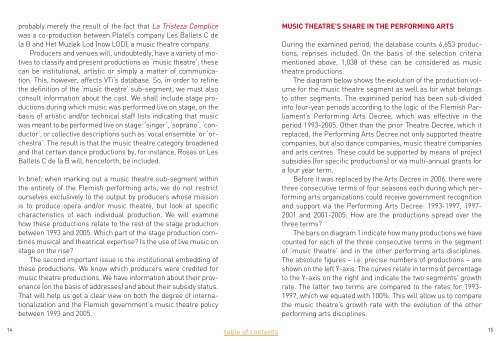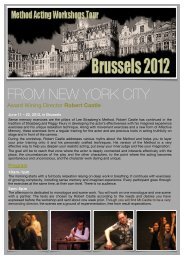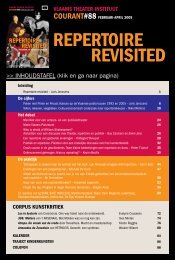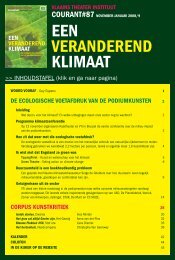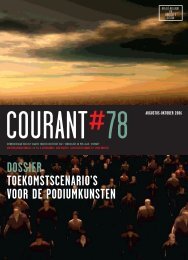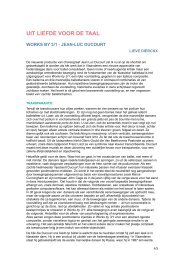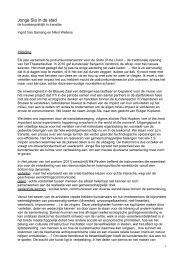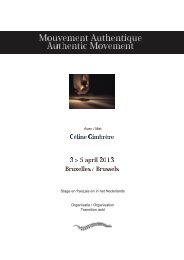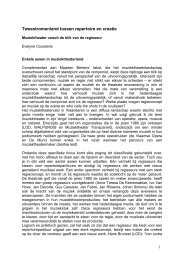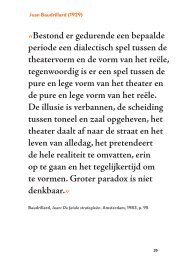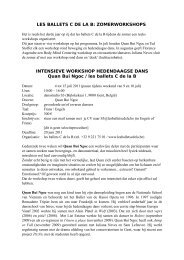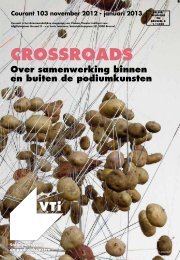music theatre in flanders - Muziekcentrum Vlaanderen
music theatre in flanders - Muziekcentrum Vlaanderen
music theatre in flanders - Muziekcentrum Vlaanderen
You also want an ePaper? Increase the reach of your titles
YUMPU automatically turns print PDFs into web optimized ePapers that Google loves.
probably merely the result of the fact that La Tristeza Complice<br />
was a co-production between Platel’s company Les Ballets C de<br />
la B and Het Muziek Lod (now LOD), a <strong>music</strong> <strong>theatre</strong> company.<br />
Producers and venues will, undoubtedly, have a variety of motives<br />
to classify and present productions as ‘<strong>music</strong> <strong>theatre</strong>’: these<br />
can be <strong>in</strong>stitutional, artistic or simply a matter of communication.<br />
This, however, affects VTi’s database. So, <strong>in</strong> order to ref<strong>in</strong>e<br />
the def<strong>in</strong>ition of the ‘<strong>music</strong> <strong>theatre</strong>’ sub-segment, we must also<br />
consult <strong>in</strong>formation about the cast. We shall <strong>in</strong>clude stage productions<br />
dur<strong>in</strong>g which <strong>music</strong> was performed live on stage, on the<br />
basis of artistic and/or technical staff lists <strong>in</strong>dicat<strong>in</strong>g that <strong>music</strong><br />
was meant to be performed live on stage: ‘s<strong>in</strong>ger’, ‘soprano’, ‘conductor’,<br />
or collective descriptions such as ‘vocal ensemble’ or ‘orchestra’.<br />
The result is that the <strong>music</strong> <strong>theatre</strong> category broadened<br />
and that certa<strong>in</strong> dance productions by, for <strong>in</strong>stance, Rosas or Les<br />
Ballets C de la B will, henceforth, be <strong>in</strong>cluded.<br />
In brief: when mark<strong>in</strong>g out a <strong>music</strong> <strong>theatre</strong> sub-segment with<strong>in</strong><br />
the entirety of the Flemish perform<strong>in</strong>g arts, we do not restrict<br />
ourselves exclusively to the output by producers whose mission<br />
is to produce opera and/or <strong>music</strong> <strong>theatre</strong>, but look at specific<br />
characteristics of each <strong>in</strong>dividual production. We will exam<strong>in</strong>e<br />
how these productions relate to the rest of the stage production<br />
between 1993 and 2005. Which part of the stage production comb<strong>in</strong>es<br />
<strong>music</strong>al and theatrical expertise? Is the use of live <strong>music</strong> on<br />
stage on the rise?<br />
The second important issue is the <strong>in</strong>stitutional embedd<strong>in</strong>g of<br />
these productions. We know which producers were credited for<br />
<strong>music</strong> <strong>theatre</strong> productions. We have <strong>in</strong>formation about their provenance<br />
(on the basis of addresses) and about their subsidy status.<br />
That will help us get a clear view on both the degree of <strong>in</strong>ternationalization<br />
and the Flemish government’s <strong>music</strong> <strong>theatre</strong> policy<br />
between 1993 and 2005.<br />
MuSIC TheATre’S ShAre In The perFOrMInG ArTS<br />
Dur<strong>in</strong>g the exam<strong>in</strong>ed period, the database counts 6,653 productions,<br />
reprises <strong>in</strong>cluded. On the basis of the selection criteria<br />
mentioned above, 1,038 of these can be considered as <strong>music</strong><br />
<strong>theatre</strong> productions.<br />
The diagram below shows the evolution of the production volume<br />
for the <strong>music</strong> <strong>theatre</strong> segment as well as for what belongs<br />
to other segments. The exam<strong>in</strong>ed period has been sub-divided<br />
<strong>in</strong>to four-year periods accord<strong>in</strong>g to the logic of the Flemish Parliament’s<br />
Perform<strong>in</strong>g Arts Decree, which was effective <strong>in</strong> the<br />
period 1993-2005. Other than the prior Theatre Decree, which it<br />
replaced, the Perform<strong>in</strong>g Arts Decree not only supported <strong>theatre</strong><br />
companies, but also dance companies, <strong>music</strong> <strong>theatre</strong> companies<br />
and arts centres. These could be supported by means of project<br />
subsidies (for specific productions) or via multi-annual grants for<br />
a four year term.<br />
Before it was replaced by the Arts Decree <strong>in</strong> 2006, there were<br />
three consecutive terms of four seasons each dur<strong>in</strong>g which perform<strong>in</strong>g<br />
arts organizations could receive government recognition<br />
and support via the Perform<strong>in</strong>g Arts Decree: 1993-1997, 1997-<br />
2001 and 2001-2005. How are the productions spread over the<br />
three terms?<br />
The bars on diagram 1 <strong>in</strong>dicate how many productions we have<br />
counted for each of the three consecutive terms <strong>in</strong> the segment<br />
of ‘<strong>music</strong> <strong>theatre</strong>’ and <strong>in</strong> the other perform<strong>in</strong>g arts discipl<strong>in</strong>es.<br />
The absolute figures – i.e. precise numbers of productions – are<br />
shown on the left Y-axis. The curves relate <strong>in</strong> terms of percentage<br />
to the Y-axis on the right and <strong>in</strong>dicate the two segments’ growth<br />
rate. The latter two terms are compared to the rates for 1993-<br />
1997, which we equated with 100%. This will allow us to compare<br />
the <strong>music</strong> <strong>theatre</strong>’s growth rate with the evolution of the other<br />
perform<strong>in</strong>g arts discipl<strong>in</strong>es.<br />
14 15<br />
table of contents


